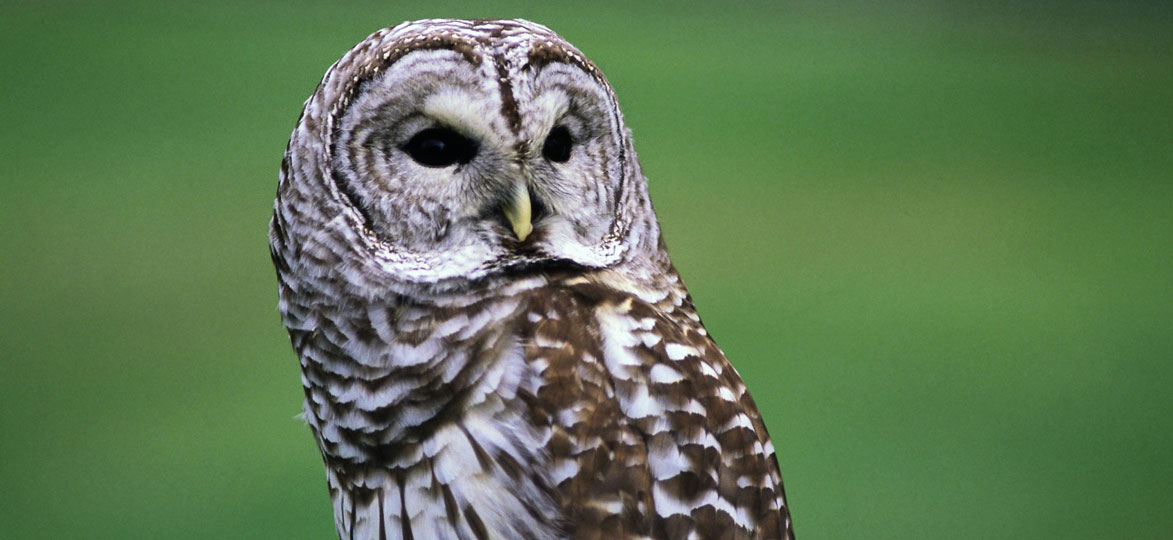
The Barred Owl (Strix varia) is more often heard than seen. Its loud call is said to be asking Who-cooks-for-you, who-cooks-for-you-all.
It usually spends its day in a thick grove of trees in a low, wet forest, and is seen only by those who deliberately seek it out. The search is worth the effort, however, for this owl has beautiful "barred" plumage, or feathers, with black and white stripes. The Barred Owl is one of the most common species of owl in North America east of the Rocky Mountains.
Habitat
The Barred Owl prefers extensive mature deciduous forests, such as river bottomlands, northern hardwoods, and oak-hickory forests, but is also found in mixed conifer-deciduous forests and less commonly in spruce-fir forests of Vermont. It may hunt at night over meadows or within the forest interior.
Its preferred nesting site is the hollow of a tree but it will frequently use abandoned hawk, squirrel, and crow nests. Typically, this monogamous bird will use the same nest site year after year.
The Barred Owl is a nocturnal, but is often seen or heard during the day, especially on winter afternoons or when skies are overcast. During the day, the barred owl roosts in shady mature forests, usually on a limb next to the trunk of a tree. During hot weather, it can often be found in the upper part of a large white pine tree where there is a breeze that helps keep them cool.
During cold wintry weather it usually roosts lower in the canopy where the vegetation is denser and the wind is not as strong.
The Barred Owl is often mobbed by other birds while on its roost, particularly by crows, Blue Jays and American Robins, and a keen observer can locate an owl roost by being aware of this mobbing while out in the woods.
Reproduction
Using natural cavities 20-40 feet high in a large tree, stick platform nests created by other animals, or nest boxes, Barred Owls lay one to five eggs. The incubation period is about 28-33 days, and the chicks hatch helpless with closed eyes and covered in white downy feathers.
Diet
The Barred Owl is a bird of prey and catches food with its sharp talons and hooked beak. It is nocturnal, active mainly at night, but will feed during the day if necessary.
It has a varied diet, which includes small mammals, birds, reptiles, amphibians, fish and invertebrates. The Barred Owl is undoubtedly an opportunistic feeder, taking whatever is available.
The Barred Owl typically hunts for its prey while sitting on a perch. Like many other owls, it swallows its prey whole and then, when at a more sheltered location, regurgitates the indigestible materials, such as bones and fur, in the form of pellets.
An owl will often use the same perch for feeding, which can be easily identified by the collection of pellets on the ground below.
Management
Today the most serious threats to Barred Owls in Vermont include the loss of habitat from housing development, recreation development in areas where Barred Owls breed, and forest management that doesn't consider including mature forest as a benefit for wildlife habitat.
Roads are also a serious problem because Barred Owls are attracted to grassy roadsides, which harbor rodents. Many owls are killed each year in automobile collisions.
As Barred Owls are cavity nesters, they have been known to use human made nest boxes for laying and hatching their eggs. The Eastern Screech and Barn are two other owl species in North America that can be attracted to and will use nest boxes.
Status
Current Barred Owl populations within Vermont are stable. There is no active plan designed for these owls, but continued monitoring is conducted to ensure that their population remains healthy and abundant in Vermont.
